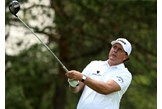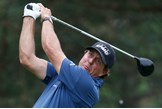We’re not very happy with Phil Mickelson
Published:
The videos posted on the PGA Tour YouTube channel normally showcase the best moments of recent action from golf’s biggest professional tour.
This week, they posted this:
We’ve spoken about the need for players to shout fore in the past, but until it starts happening, every single time, we’ll keep saying it:
IF YOU HIT A PROJECTILE TOWARDS ANOTHER HUMAN BEING THAT HAS THE POTENTIAL TO KILL THEM, IT’S POLITE TO AT LEAST GIVE THEM A LITTLE WARNING.
This video is everything that’s wrong with the issue of players not shouting “fore”.
First, Mickelson hits a shot that he knows is off-line. You can tell from the anxious look on his face. He even bites his lip.
No one shouts fore. Not Mickelson. Not his caddie. Not one of his playing partners. Not one of their caddies. Not a course marshal. No one.
Whenever this topic comes up, which is far too often, a few people always respond by saying “you wouldn’t hear a shout from 300 yards away anyway”.
Anyone who’s ever been on a golf course and heard a shout of “fore” will know that, quite simply, yes, you would.
Others will suggest that players don’t shout “fore” in case it distracts other players on the course, and that pointing an arm in the direction the ball is going is sufficient warning.
Hold on.
Let’s get this straight.
Spectators 300 yards away can’t hear someone shouting at the top of their voice, but they can see that same person vaguely waving an arm in their general direction?
Right…
Let’s just check the science on that.
A human shout produces a sound around 80-120 decibels. 300 yards away, depending on the air pressure, wind direction and so forth, you can hear that sound as clearly as a nearby percolating coffee maker or a car driving right past you. In short, unless there’s a gale force wind blowing in the opposite direction or you’re wearing headphones blasting out gangster rap, you will be able to hear the shout of “fore”.
If there had been a shout from the tee after Mickelson hit that shot, the spectators in the vicinity his ball was headed would have been able to protect themselves. As it was, and as you can tell from the video, they had no idea they were in any danger. The first movement from any of them comes after the ball lands on the spectator’s head.

The next thing that troubles us is the fact that this occurence is so commonplace it’s treated with lighthearted jest by all concerned.
“Lucky he’s got a hat on,” says Nick Faldo.
Is it, Nick? Because soft cotton hats are renowned for their high levels of protection? During World War II you couldn’t move for soldiers wearing cotton panamas, could you?
“If your head was a touch softer, I’d be in the fairway,” jokes Mickelson as he ambles over to the hard-headed spectator with a signed glove by way of apology. Everyone laughs. Ho ho ho. People have died after being hit in the head by golf balls before. Ha ha ha. Others have lost an eye. Tee-hee-hee. A golf ball hitting you on the head can cause strokes and brain damage. Isn’t it funny, though?
The spectator, as is typically the case in these situations, takes it all in good spirits, gladly accepting the signed glove, shaking Mickelson’s hand and posing for the cameras.
“Thanks for your help this week,” says Mickelson. “I appreciate you being out here and giving the assist.”
The assist.
We’ve spoken before about players knowing that a deflection off the gallery is likely to prevent a wayward shot from going deeper into trouble. That’s a truly shameful way of thinking. Sure, golf tournaments are important and there are millions of pounds on the line, but they’re never more important than not killing someone.
“Good job, Phil!” shouts one spectator as Mickelson strolls off to play his second shot.
And finally, in the list of things wrong with this video, there’s the simple fact that the PGA Tour posted it at all. As we said at the start, it’s posted in amongst the best moments of PGA Tour action. Are they suggesting this moment is something to be celebrated? We’ve called upon golf’s governing bodies to do something to force players to start shouting “fore”, and now they seem to be doing the exact opposite: highlighting an example of a top player not shouting fore and benefitting from it.
This issue is far from specific to Phil Mickelson, of course. This story could just as easily be about any number of tour pros. In fact, if the PGA Tour were looking for videos of players not shouting “fore” when they should have done, they’d have no shortage of material. “I”d say only 10 per cent of PGA Tour players consistently shout fore when they should,” says Denis Pugh.
Imagine someone does get seriously injured at a tour event soon. Would we be able to look back and say, ‘Well, we had no way of knowing that was going to happen. This is a totally freak accident.’? No we would not. We’d be able to look back at countless incidents and realise that actually it was only a matter of time before the luck ran out.
Let’s do something before we get to that point.
Let’s have immediate one-shot penalties for any player who hits a shot off-line and doesn’t shout fore. It won’t guarantee that a spectator will never get hurt, but it will greatly reduce the risk.


